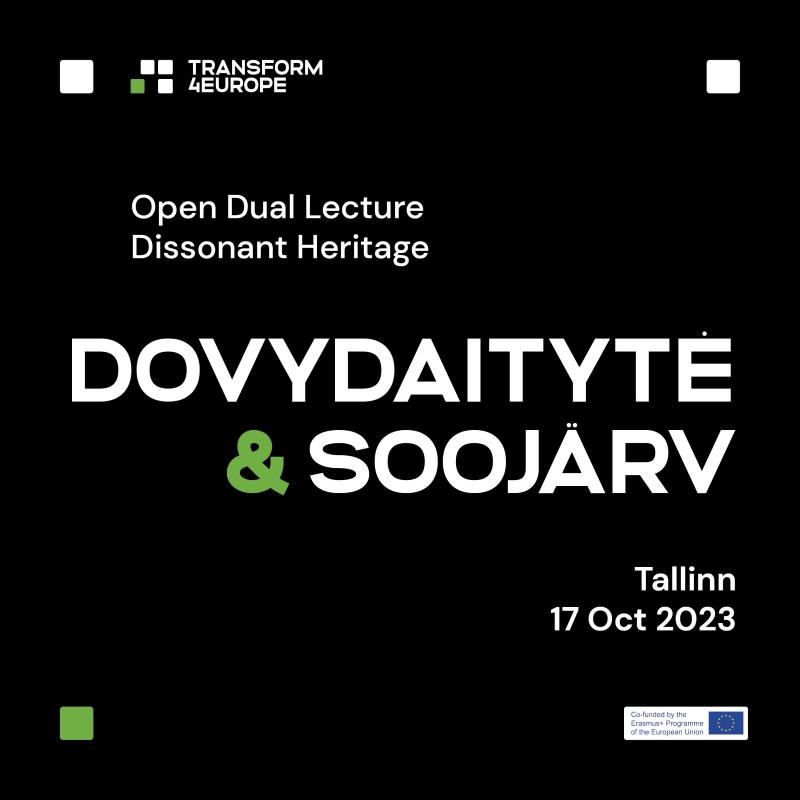Open Dual Lecture in Tallinn
“Dissonant Heritage: Re-evaluating the Soviet Legacies”
17 October 2021 | Estonian Academy of Arts
About
On October 17, at 5 PM EEST the Estonian Academy of Arts will organize an open conversation / lecture with two speakers, where academic knowledge and practitioner are discussing about the dissonant heritage from the Soviet Legacies.
The dual lecture with Linara Dovydaitytė PhD (VMU) and Anu Soojärv (EKA) will explore both local and transnational aspects of dissonant heritage in relation to Soviet legacies. Since Russia’s full-scale invasion on Ukraine in February 2022, Russian political behaviour, both in present and past, has been discussed across Europe and beyond as never before, including scrutinising Soviet and Russian-related heritage as one of the reactions to the aggression. This has resulted in creating new and opening up old conflicts between different communities. On the other hand, the situation gives a much needed opportunity for countries and memory groups to acknowledge their collective suppressed conflicts, provoking discussions that had been put on hold for decades. In this delicate process, transregional exchange of comparative experiences is substantial, paving the way for balanced discussions and cross-disciplinary expertise on heritage protection.
The event is moderated by Andres Kurg PhD, Senior Researcher at the Institute of Art History and Visual Culture, Estonian Academy of Arts.
Link to the youtube channel: www.youtube.com/live.
Speakers
Linara Dovydaitytė
Nuclear Legacy as a Dissonant Cultural Heritage
Dovydaityte will talk about her research on the atomic town Visaginas with its mostly Russian-speaking community undergoing radical changes due to the decommissioning of the Soviet-designed Ignalina Nuclear Power Plant in Lithuania. She will present nuclear heritage making as a means to cope with societal challenges discussing how it is possible to articulate the dissonance when heritage is created by or together with a community.
Linara Dovydaitytė writes on Soviet art and heritage, visual culture, and museum studies with a focus on memory politics, community involvement and public communication. Recently she has been investigating how nuclear heritage is created and used as a cultural resource by communities and organisations to cope with societal, economic, and environmental challenges.
Anu Soojärv
“Taming” Soviet Heritage: Reassessment and Conservation of the Mural “The Friendship of the Nations”
When the mural “The Friendship of the Nations” was opened to the public in 1987, it created quite a furor for bearing such an expressive Soviet aesthetics when the significant series of events known as the Singing Revolution had just started to take place. In 2017 the contradictory mural was conserved alongside with the hall it is located in. In the process the “The Friendship of the Nations” was covered with a special glass that created a possibility to make the mural invisible when needed. In this manner, “The Friendship of the Nations” became the first Soviet mural of it’s kind in Estonia, to be adapted to the new perceptions.
Her field of research is Estonian monumental art in the Soviet era, focusing on the role of public monuments in identity formation of local communities. In her everyday work she is mapping and documenting public monuments and works of art from the perspective of preservation and data gathering. She is a doctoral student and a junior researcher in EKA at the department of Cultural Heritage and Conservation.
The event will be broadcast live on YouTube, but you can definitely have a more exciting discussion experience when you join us in Maarjamäe Castle at the Summer Hall (Suvesaal), doors open at 4:30 p.m.



